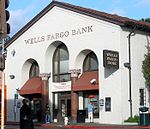St. John's Presbyterian Church (Berkeley, California)
American Craftsman architecture in CaliforniaBuildings and structures in Berkeley, CaliforniaChurches completed in 1910Churches on the National Register of Historic Places in CaliforniaJulia Morgan buildings ... and 4 more
National Register of Historic Places in Berkeley, CaliforniaShingle Style architecture in CaliforniaShingle Style church buildingsTourist attractions in Berkeley, California

The Julia Morgan Theater, located in the former St. John's Presbyterian Church, is a historic building in Berkeley, California designed by architect Julia Morgan. The wooden building at 2640 College Avenue is built in the American Craftsman style with an exterior wood-shingle finish known as Berkeley Brown Shingle. The church building was desanctified and sold when the congregation moved to a new building in 1974. It now houses the Berkeley Playhouse. The structure is #8 on the city of Berkeley's list of historic landmarks. In 1975 it was added to the National Register of Historic Places (listing #74000507).
Excerpt from the Wikipedia article St. John's Presbyterian Church (Berkeley, California) (License: CC BY-SA 3.0, Authors, Images).St. John's Presbyterian Church (Berkeley, California)
Derby Street, Berkeley
Geographical coordinates (GPS) Address Nearby Places Show on map
Geographical coordinates (GPS)
| Latitude | Longitude |
|---|---|
| N 37.862222222222 ° | E -122.25222222222 ° |
Address
Derby Street 2729
94705 Berkeley
California, United States
Open on Google Maps







